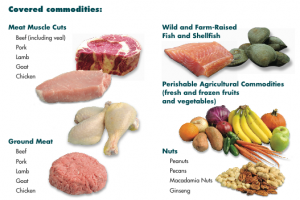 COOL identification for covered food items is something all consumers should be familiar with, yet many still are not.
COOL identification for covered food items is something all consumers should be familiar with, yet many still are not.
Regulations regarding COOL identification went into effect back on March 16, 2009.
USDA’s Agricultural Marketing Service (AMS) maintains responsibility for the implementation, administration and enforcement of COOL regulations.
Just how familiar are you with COOL food regulations?
Background Behind COOL Regulations
COOL stands for “Country of Origin Labeling” and it affects some, but not all of the food items consumers purchase through specific types of retail sources. Although retailers provide the information to consumers, often it is suppliers that are ultimately responsible for passing along accurate information to the retailer in regard to COOL regulations.
The main logic behind COOL food item identification is that it will help consumers make more informed purchasing decisions in certain (but NOT all) retail establishments. It is NOT a food safety law, nor is it a food inspection law, although violation of the COOL regulations in the US is subject to investigation, notice, hearing and imposition of fines upon establishments of up to $1,000 per offense.
Such labeling can be accomplished in a variety of ways that allow a consumer to identify the country or countries of origin of covered commodity food items. Examples of such labeling include band, label, pin tag, placard, sign, sticker, twist tie or even a checked box on a product’s container.
Although the information provided must be considered legible and placed in a conspicuous location, there is no specific color, font size, or typeface a retail location must use.
When home delivery or internet sales are involved, COOL information can be provided on the delivery vehicle or otherwise at the time the product is delivered to the customer (think about ordering groceries online from certain retailers).
Where Do COOL Regulations Apply?
If you shop at a retail club warehouse store, full-line grocery store, or supermarket, then you definitely need to know about COOL food regulations and how they affect YOU! (Note that if you purchase items that are farmer-raised directly from a farmer via a community supported agriculture (CSA) program, farm stand, or farmers market, COOL regulations do not apply).
The Perishable Agricultural Commodities Act (PACA) requires that certain high volume retail establishments provide certain COOL information to consumers about some specific commodities that they buy. PACA licensed retail establishments which spend at least $230,000 annually on perishable agricultural commodities (fresh & frozen fruits & vegetables) must comply with COOL regulations. (Among those exempt from COOL regulations are butcher shops, convenience stores, exporters, food stands, and fish markets. Note that salad bars and delis providing ready-to-eat food items within retail establishments are exempt from the law, as are food service establishments including delicatessens & restaurants).
What Commodities Do COOL Regulations Cover?
COOL food regulations involve specific covered commodities sold at certain locations such as:
- ground meats and muscle cut meats including beef, chicken, goat, lamb, pork, and veal (young beef);
- farm-raised & wild-raised fish and shellfish;
- fresh and frozen fruits and vegetables;
- specific nut and nut products such as peanuts, pecans and macadamia nuts; also ginseng
Although unprocessed food items are subject to COOL regulations, processed food items are NOT subject to those regulations.
When shopping at stores subject to COOL regulations, processed food items include anything that has been cooked, combined with other ingredients, cured, restructured, or smoked. The addition of any component such as salt, sugar or even water that enhances or represents further “preparation” of a product offered to consumers technically results in a processed food item for purposes of the COOL regulations. If items are breaded, chocolate coated, have added tomato sauce, etc., then they are not subject to those specific regulations.
That means if you buy:
- raw chicken or chicken parts, they are subject to COOL regulations; while rotisserie BBQ chicken from the same retail store is not;
- tuna filets from a store they are subject to COOL regulations, while canned tuna is not;
- fresh peanuts from a store they are subject to COOL regulations, while roasted peanuts are not;
- plain raw pork tenderloin roast it is subject to COOL regulations, while marinated pork tenderloin roast is not;
- ground meat it is subject to COOL regulations, but meatloaf mix that contains anything other than covered ground meat content in it is not;
- fresh intact fruit from a retail store it is subject to COOL regulations, but fruit salad is not;
- bacon, ham for Easter, etc., are not subject to COOL regulations.
When multiple countries of origin are involved in terms of where say an animal was born, raised, and then finally slaughtered, the resulting labeling language can get rather involved. For example, let’s say an animal was born in Mexico, but raised in Canada, and finally went to slaughter in the US. The COOL regulations note that the product would have to be identified as a “Product of Mexico, Canada and the United States” (although the countries can be listed in any order). A similar designation would have to appear for labeling purposes if meat from various national sources was commingled prior to being sold at retail in a covered establishment.
Right now the COOL regulations applying to muscle cut meats coming from both Canada and Mexico are under review and there is a comment period that lasts until April 11, 2013. Those proposed changes were published in the Federal Register back on March 12, 2013.
The World Trade Organization’s (WTO) Appellate Body determined that the United States (US) COOL requirements for certain meat muscle cut food items discriminated against Canadian and Mexican sourced products and thus were “inconsistent” with a WTO Technical Agreement on Barriers to Trade. The US has until May 23, 2013 to come into compliance with the WTO ruling regarding COOL.
So the next time you head to one of the covered retail stores selling grocery items, be sure to look for any applicable COOL information when making your purchasing decisions.
P.S. You can catch a video about COOL regulations that have been in effect on youtube.

